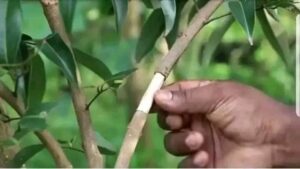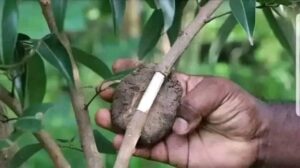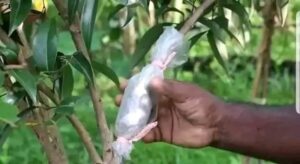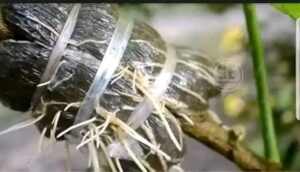Air layering in Litchi is an asexual method of plant propagation in which the plant part is subjected to rooting when it is still attached to the parent plant.
This method usually includes wounding of a stem and that wound is wrapped with the rooting medium to let it root. It is the simplest and easy way of propagating the plant. This method of propagation is also required for production of identical copies of the mother plant. Air layering is also supposed to occur naturally. Rooting occurs in the stem or branches that touch the ground. It is important practice in Litchi Farming.
Air layering can be carried out throughout the year. However, the best time for layering is early to late spring or mid-summer when the plants are actively growing. In spring bark is slipping and can be easily removed.
Branch Selection
Branch must be healthy and actively growing. It must be one to two years old. Air layering requires branch size of between 2 to 3 feet long and pencil size thickness
Plants That Can Be Air Layered
Many plants including shrubs, flowers, vines, houseplants, bushes and trees can be air layered. The success of layering depends upon the growth rates, hardiness and environmental conditions. Plants that can be air layered are listed below:
| Fruit Trees | Apple, Pears, Apricot, Litchi, Barbados cherry, Persian limes, Citrus, Guava, Mango |
| Flowering Shrubs | Camelia, Roses, Rhododendron, Jasmine, Bougainvillaea, Hibiscus |
| Foliage Plants | Ficus, Crotons |
Requirements For Air Layering In Litchi
i. Rooting media
Sphagnum moss or peat moss is used as rooting media. Sphagnum moss is the dehydrated remains of the sphagnum. It is lightweight and can absorb water 10 to 20 times its weight. At first the sphagnum moss is soaked in water and then it is squeezed to remove the excess water. Generally a handful of sphagnum moss is used.
Saw dust, barks and even damp soil can be used as rooting in case sphagnum is not available.
ii. Plastic
Thin transparent plastic is usually preferred. Plastic holds the rooting media and keeps the rooting medium moist and damp. It must be 4-6 millilitre thick, 6 inches wide and 10 inches long.
iii. Rooting Hormone
Rooting hormones like IBA are preferred but are not necessary.
iv. Sharp Knife
It is an instrument that is used to pull out the bark. The blade of the knife should be sharp.
v. Thread
Both ends of the plastic are tied with the thread. It is necessary to maintain the humidity inside the stem.
Procedure (Step By Step) Of Air Layering In Litchi
Following are the step wise procedure that you need to follow:
Step 1: Selection Of Branch
At first a one to two year old terminal branch is selected. Generally non-flowering branches are selected. The selected branch must be straight, healthy and vigorous. The length of selected 2 to 3 feet and thickness 1 to 1.25 cm.
Step 2: Girdle The Stem

First remove all the leaves from the area to be girdled. The bark should be removed. Under the bark, there exists an actively dividing layer called as cambium which should also be removed. Another layer that should be removed is phloem. For this the stem is marked at two points. The distance between the two points must be 4 cm.
Step 3: Applying Rooting Hormone
It is not mandatory but application of rooting hormone facilitates rooting.
Step 4: Applying Sphagnum Moss

The girdled area is then bunched around or over with the handful of moist sphagnum moss.

Then it is covered with thin transparent plastic and tied at the both ends with the help of thread. This will help to hold the moss on the thread. This structure is called a Gootee. It is only for a few days for rooting.
Step 5: Cutting Rooted Stem

Depending on the species, roots are formed after 2-3 weeks or 1-2 months. Young root tips are clearly visible from the Gootee. After new roots are visible through the sphagnum moss, the plastic sleeve is removed. The rooted stem is cut just below the rooted section from the mother plant.
Step 6: Transplanting The Layered Branch
Then the layered branch is transplanted in soil/pot/ poly bag as a new sapling.
What Is Girdling?
During air layering the bark, the cambium and the phloem layer are removed by cutting. However, the xylem is left intact. This process is known as girdling. Due to girdling carbohydrates and photosynthates flowing down from the leaves gets accumulated at the girdled side. This helps in inducing roots.
Advantages Of Air Layering
- A good sized plant can be produced within a week. Otherwise in seed propagation it requires months or even years.
- Some plants don’t produce seed. In such cases air layering is the only alternative.
- Plants are genetically identical to the parents.
- Air layering has a high success rate.
- The juvenile period of the plant can be shortened. Time required by the plant to reach the full bearing stage is known as juvenile period.
- Time and space is saved.
- Both mother plant and new plant continue their growth.
Disadvantages Of Air Layering
- It is a labour intensive method.
Precautions
1. The selected branch must be one to two years old and actively growing.
2. You have to select the terminal branches.
3. The selected branch must be straight, vigorous and healthy.
4. Always use a sharp knife for girdling.
5. Make sure that cambium layer is removed. Otherwise the girdled area may be filled by an active growing cambium layer and rooting may not occur.
6. The sphagnum moss must be moist but not soggy.
Conclusion
Air layering is the easiest method of asexual propagation. In this method, the stem is induced to root when it is still attached to the mother plant. Sphagnum moss are commonly used as rooting media. Apart from sphagnum moss, damp soil, and saw dust can also be used as rooting media. At first a healthy fast growing non-flowering branch is selected and is girdled at the desired section. Girdling stimulates rooting. During girdling the cambium layer should be removed. If it is not removed, phloem will be regenerated and the wound is healed. So, rooting does not occur.
